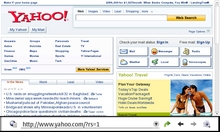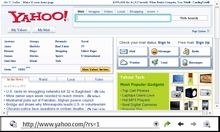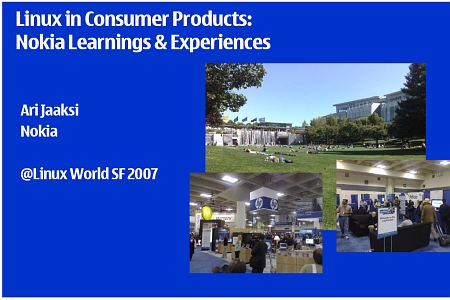Nokia director speaks on Linux, open source
Aug 9, 2007 — by LinuxDevices Staff — from the LinuxDevices Archive — views SAN FRANCISCO — “Linux is the launching pad you need to stand on to be productive,” said Nokia's open source director, Ari Jaaksi, at LinuxWorld Wednesday. “We have never managed to bring out a product in such a short time, with so few resources,” he added, referring to Nokia's Linux-based Internet tablets.
SAN FRANCISCO — “Linux is the launching pad you need to stand on to be productive,” said Nokia's open source director, Ari Jaaksi, at LinuxWorld Wednesday. “We have never managed to bring out a product in such a short time, with so few resources,” he added, referring to Nokia's Linux-based Internet tablets.
Jaaksi's talk was well-attended, despite Motorola giving away T-shirts and exotic mini-USB phone cables to entice conference attendees to attend its MotoDEV event next door.
While raving about the benefits of open source, Jaaksi also acknowledged some real challenges. For example, he observed that even though companies might like to freeze some software in order to maintain backwards compatibility, “you can't stop the community. Everyone else will start to use features in a new release, and pretty soon nothing works. In our case, we had to upgrade our kernel less than two months before shipping. I wouldn't like to do that, but sometimes you have to.”
Another challenge is to interest community developers in the final fit, finish, testing, and integration phase of software development. “Once the basic application service is working, a developer is happy with it. It's only about 50 percent done, though. You still have to do internationalization, make sure it doesn't use too much power, and other things.”
For that reason, Jaaksi believes that community development alone will never be able to produce finished consumer products by themselves, without corporate involvement of some kind. “I'd like someone to prove me wrong on that count,” he also said, acknowledging that he is following the OpenMoko project closely.
Jaaksi said he is often asked about competitors taking advantage of Nokia work done under an open source license. He says he typically replies, “Yes, they can steal the software, but we've been building the community, and that's a valuable asset as we go forward. Do [competitors] know who to work with to get what they need done? When we show up and say we are Nokia, it has a positive connotation, and helps us get things done there.”
Jaaksi ended his talk with a statement emphasizing just how important he believes open source has become for product companies: “Using software from upstream projects and participating in the community work are the skills to learn for all hi-tech companies. These skills will become valuable assets that no product development companies can live without.”
At the same time, Jaaksi said he believes commercial software actually has growing import for consumer devices, particularly at the top of the software stack. He said Nokia ported Adobe's Flash 9 Player to ARM in order to use it on the N800. “As far as I know, the N800 is the only pocketable device that supports Flash 9,” he added.
Nokia also recently announced commercial relationships for N800 ports from ISVs that include Real Networks (story), Skype (story), and Navicore (story).
Background
Jaaksi included lots of background in his talk. He said the 770 was originally conceived as a better way to get online. “We thought, there must be a better way to get online, without booting up a PC.”
Nokia designed its Internet tablets around well-tested GNOME desktop libraries, rather than the embedded components typically used in low-powered devices. “We didn't want to create special embedded versions of all the components,” he said. And, he said, Internet tablet use is similar to PC use, albeit with some differences. “Sessions are shorter, with little sniplets of activity, like checking email or a web page.”
The choice to use desktop software components apparently worked out well, given Jaaksi's comment, “Without exception, the code we get upstream is better than what we write in-house. That's because all of you out there are testing it for us. Quality is the big reason to base products on open source.”
Jaaksi observed that desktop rather than embedded software is now being used by several other high-profile device software projects, including projects at Intel (Moblin), Ubuntu (UME), and GNOME (GMAE). Jaaksi hopes some or all of these will use the Nokia-developed Hildon application framework, which he called Nokia's “main contribution” to open source device software.
Nokia's other contributions are evident in the Nokia-sponsored Maemo open source project. The name came from a password generator, and doesn't mean anything, Jaaksi said. Maemo is based on Debian, but is not yet supported as a real distribution in its own right, in part because package management has not yet been implemented fully. This results in Nokia continuing to offer upgrades as wholesale image downloads that over-write the user's own data and applications, rather than the slicker incremental upgrades available via apt-get, aptitude, and other Debian utilities.
One feature of Maemo is a “garage” hosting hundreds of software development projects. Garage projects that reach a reasonable level of completeness may then receive promotion on Nokia's 

Opera and Gecko renditions of Yahoo
(Click to enlarge)
Tableteer also features new software developed by Nokia through partnerships, such as the recent MicroB Gecko-based browser developed in conjunction with Mozilla. “The Mozilla-based browser sometimes seems slower than Opera, but it is actually processing all of the AJAX that Opera just throws away.”

Dr. Ari Jaaski's LinuxWorld 2007 talk slides
(Click image to download slides)
Jaaksi's talk ended with a lively question/answer period. The complete presentation slides are available for download here.
This article was originally published on LinuxDevices.com and has been donated to the open source community by QuinStreet Inc. Please visit LinuxToday.com for up-to-date news and articles about Linux and open source.